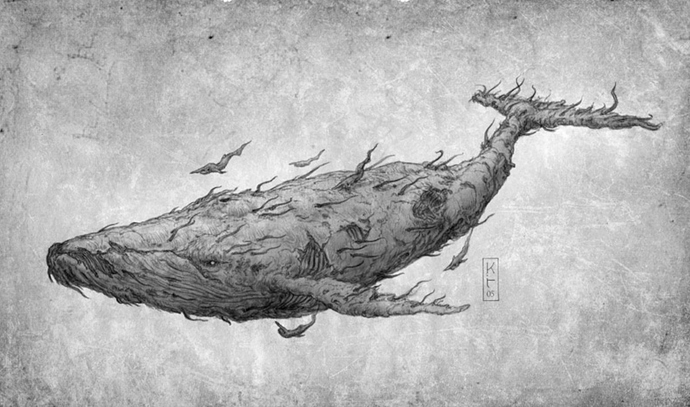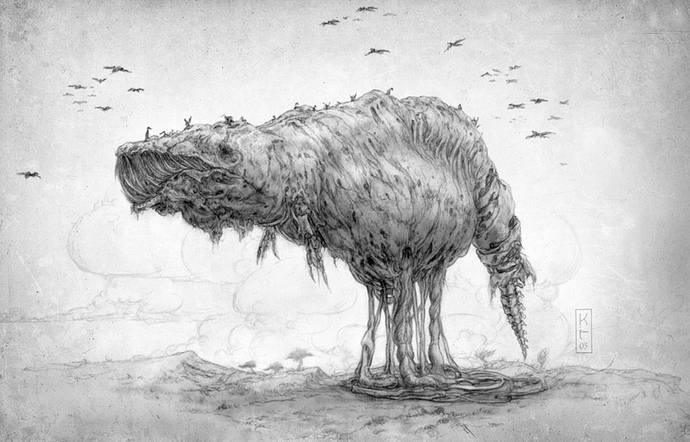HI everyone,
I’ve been slowly gestating an idea for the whales of Athas and how aquatic creatures might work in a sea of silt. Below is the in-game background to the whales. I hope to provide some 3.X stat blocks for actual types of whales over the next couple of weeks; they’ll be posted on this thread.
Feedback and constructive criticism welcomed.
The Whales of Athas
Eerie, low sounds echoed across the sea. A pearl grey fin sliced through the dust, streaking toward the white horror. Four more fins rose and converged on the predator. Explosions of silt obscured all bar apparitions of rounded maws, and razor sharp teeth. Within seconds the largest of silt horrors was ripped apart and the attackers disappeared beneath the surface of the silt sea, the wordless songs fading as time passed.
In the Sea of Silt, all manner of terrors try the sanity of those brave or foolish enough to venture far from shore. Many sailors who survive deep silt voyages have nightmares of giant attacks, avian assaults and tentacled horrors. Less common stories talk of eerie, wordless songs that echo across the dusty expanses.
The rarest of old seadog tales not only talk of low songs, but of being saved from silt horror attacks by packs of finned creatures, hidden beneath the dust. Not that they are seen as saviours, for these unknown predators will splinter decks and shatter spars as they ram the silt skimmers they so recently saved.
A lament of what was
Life on Athas is ancient. Millennia mark the transitions through the ages, from the Brown Age, back through the Red Age of the Cleansing Wars, the Green Age of Magic and Psionics, to the Blue Age of the world ocean and the life-shaped civilisation of the rhulisti. The Sorceror Monarchs, the Pyreen and other ancient beings are unanimous in their view that the halflings are the oldest civilised race, the one which all others sprung from.
Of course, they’re wrong.
Before the rhulisti built their civilisation, dark shapes swam with sentient purpose beneath the waters of the Athas-That-Was. Great epic cycles of song echoed through the oceans, a planet spanning melody voiced by beings who simply called themselves the People; the whales of Athas.
In the days of the World Ocean, the whales built a great civilisation, encoding the wisdom of ages in their songs. They were friends with the dolphins of Athas, from the first ages of the world. After the halflings rose to prominence, the People allied with the rhulisti, who called them ‘Ghesh-utuil’ – the Wise Makers. Guided by the greatest of their number, the ageless Speaker of the Seas, the People prospered greatly. The alliance between the People and the rhulisti brought great fertility to the oceans. As the halflings built great cities floating on the oceans, so the People built great structures beneath the waves.
If asked, the dolphins of Marnita might suggest it was the whales who developed life-shaping, later teaching it to the halflings, although the truth is unclear. What is clear is that the Wise Makers had their own life shapers and they accomplished incredible feats of their art, both alone and in collaboration with their increasingly prideful allies.
Eventually the arrogance of the rhulisti life-shapers grew beyond bound. The war with the nature benders and the inadvertent creation of the Brown Tide threatened to obliterate the People. In panic, and without consulting their allies, the rhulisti triggered the Green Age, destroying the world-spanning ocean and restricting the People to the seas that remained.
From the first days of the Green Age, the People turned their backs on the races created during the Rebirth, bitterly regretting ever communicating with the halflings. And so during the millennia of the Green Age the People shunned contact with all save the dolphins. All through their association with the dolphins, the People had experimented with psionics, but never truly embracing the Way. Forced to defend themselves against being hunted by the Rebirth races for food or sport or territory, the People developed psionic defences and skills to better protect themselves.
However, their numbers were never enough to outmatch the rhulisti’s mutated progeny and gradually the whales retreated further and further away from shore, abandoning any settlements and hunting grounds close to the land. Ultimately, this was what saved the People from extinction. When the seas began to turn to dust, the greatest life-shapers and scholars of the People gathered to try and reverse the process. They swiftly realised the dessication was beyond their ability to reverse. If they couldn’t change the world to suit them, they would have to change themselves to suit the new world. The world might turn to dust, but the People would survive.
In desperation, the Speaker and his most adept shapers wrought great and terrible changes upon their People. All bar a few recusants were altered. Now the people could innately float through the dust as well as they could water. Too they were able to extract oxygen from the tides of silt, without having to surface for air. The warrior caste grew hardened scales of armour and their teeth were sharpened to deadly weapons, the better to defend the few remaining bastions of cetacean life. The tenders and makers adapted to the arid conditions of the world and created new grafts, tissues and life shaped animals to sustain their civilisation.
The energies involved in changing an entire civilisation were immense. Without a structure like the Pristine Tower to moderate and focus those energies, the consequences were dire. The Speaker and his adepts were themselves changed, their life force siphoned into their People and shaping engines and became undead vestiges of their former greatness.
Today, the Withered King and his Darkened Masters (the Baen-Usaer to the common People) reign over a subsurface realm of faded glory, aged beauty and fallen dreams. The King and the Dragon have contended in the past and fought each other to a standstill. Now both are content to ignore the other as long as their plots don’t interfere with one another. No one else on Athas, bar a few of the surviving Champions and some pyreen even know the whales exist. Andropinis does, for his silt fleets have sometimes roused the ire of the People and paid the bloody price. Daskinor too remembers the whales, another hideous nightmare for his psychosis and paranoia to fear.
With the fall of Kalak, a new wind of freedom and change has blown across the land of Athas. The wind also blows across the sea of silt and for the first time in a thousand years, the Parched Kingdom has taken notice of events beyond its borders, for change has never been kind to the People and they will no longer be passive observers to their fate…

